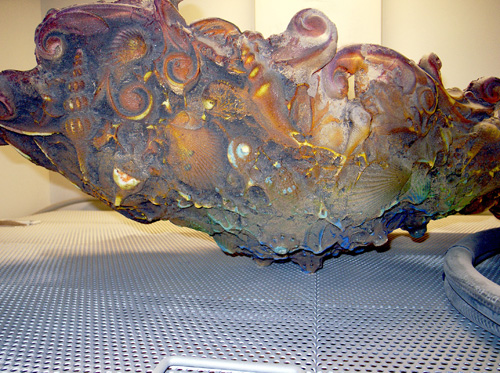Second Guyson Blast Machine For Art Glass Studio
Amanda Brisbane, the UK’s foremost sand cast glass artist, has recently installed her second Guyson Euroblast® Blast Cabinet into her Shropshire based glass works.

Amanda Brisbane Glass SculptureThe Euroblast® Cabinet will help satisfy the expanding international demand for her art glass sculptures.
This latest machine, a Guyson Euroblast 7SF (suction feed) cabinet, was chosen because it allows almost a metre and a half width of component that can be blasted compared to the existing Euroblast 6SF which has a maximum width of a metre. Both have the added user benefit of having front, top and side opening doors allowing maximum ease of access for loading and unloading large components, as in this case.
Much larger cabinets are available from Guyson, all the way up to two metres square, but size constraints of the work environment access doors in the old renovated barn meant that a Euroblast seven was the largest cabinet that would fit.
Both of these cabinets are in use for large parts of every day, by Amanda’s assistants Gail and William, to keep up with the busy throughput. The degree of blasting is critical in bringing out the full beauty of the colours created by the oxides added to the glass and imparting just the right degree of texture to the glass surface, so must be handled extremely sympathetically and with an artistic eye.
Amanda creates her beautiful sand casted works of glass art by first creating impressions, with everyday natural objects that fit with the artistic scheme that is being produced, in the green sand box template. For instance it may be scallop shells, star fish and various other seashells to create the designs used in her Seaform sculptures. These impressions create a sand mould into which hot molten glass, lifted out of the furnace on a rod at temperatures of about 1200°C, is cast. The work is undertaken at speed and with the fluency of a practiced artist.
As the molten glass begins to solidify, further embellishments to the design can be undertaken such as the laying on of gold or silver leaf. The rapidly cooling glass is then manually lifted from the sand box and manipulated into the required shape on a shaping pommel and an initial clean up of loose green sand, from the mould, is undertaken with a stiff brush.
Now the first glimpses of the unique colouring of the piece, brought about by oxides added to the glass, can start to be seen. The sand casted sculpture is then transferred to a Lehr, a temperature-controlled cooling kiln for annealing the glass, whilst the sand box is broken down and the used green sand is shovelled into a holding bin for reuse tomorrow when it has cooled down. A new wooden sided sand box is quickly constructed and green sand is sieved into it to create another mould and so the process starts again, whilst the molten glass in the furnace is at a workable temperature; the creative work is fast, very hot and undertaken at a great pace.
Once the glass sculptures have been removed from the Lehr they are placed onto wooden racking ready for their turn in the Guyson blast cabinets to have the rest of the baked on sand removed from the designed glass and help bring out the full beauty of the colours whilst imparting just the degree of desired texture to the glass surface.
CONTACT
Simon Bridge
Guyson International Ltd
Simon.Bridge@guyson.co.uk
www.guyson.co.uk
+44 (0) 1756 799911
Tuesday 14 June 2011 / file under Machinery | Engineering | Crafts


